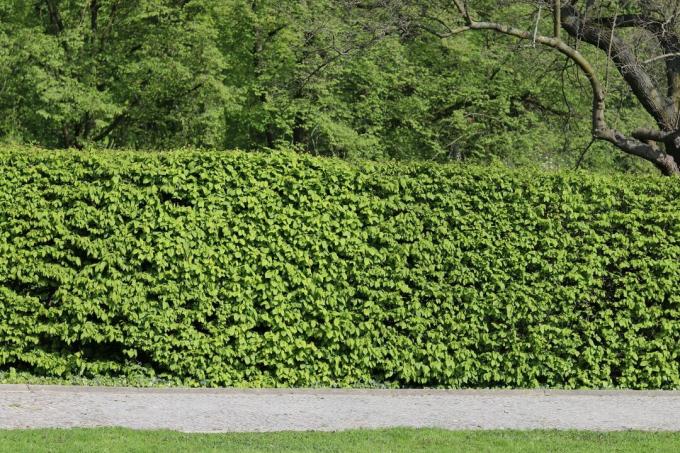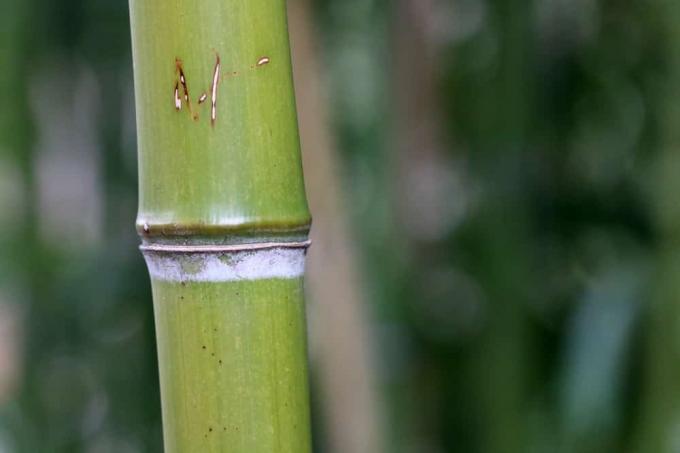

Table of contents
- growth rate
- Varieties
- accelerate growth
- Cut
The evergreen cherry laurel bears the botanical name Prunus laurocerasus and is one of the extremely vigorous shrubs that quickly grow into dense hedges. Therefore, the plant is mainly planted as a privacy screen and to limit property. However, the growth rate is not the same for all varieties and can vary greatly. However, growth can be further accelerated if necessary.
growth rate
The growth of cherry laurels is closely related to the variety and can vary greatly. In general, the plants have an extremely vigorous growth. The varieties that are offered in the trade are those that have a particularly fast growth rate. The reason for this is the intended use of the plants, which have been used as borders and privacy hedges for gardens for a long time. That is why the strong sprouting and high-growing varieties are specially bred. However, the cherry laurel not only stretches to the sky, the wood also grows vigorously in width. Therefore, growth in all directions must be considered when choosing a location. If the property is large, it can be fenced in with a cherry laurel hedge. With extensive locations, the enormous driving force of the plants does not pose a serious problem.
- Growth rate depends on the variety
- Site conditions also affect growth
- Grow an average of 25 to 50 cm in height per year
- In width, the growth is up to 35 cm per year
- Form evergreen screens within a few years
- Adapt the selected variety to the existing conditions
- When planting, keep enough distance to other plants
- Don't settle too close to buildings and fences
A notice:
In small gardens with limited space, the strong growth can soon lead to space problems. It also puts pressure on neighboring plants.
Varieties

Due to the great popularity of cherry laurels, there are now many in specialist shops to obtain different breeds, which also cover special requirements for the location become. Each of the varieties has its very special growth, the differences are particularly noticeable in the respective speed and the visual appearance.
Angustifolia
- Portuguese cherry laurel
- Grows about 3.50 m high
- Gains 20 to 40 cm per year
- Medium budding
- Growth width is 1.20 to 1.50 m
- Forms small and very dense leaves
Caucasica
- Narrow-leaved cherry laurel
- Can grow over 5 m tall
- Grows at least 25 to 50 cm per year
- Annual growth of 50 to 70 cm under ideal conditions
- Very strong shoot
- Growth width is 80 to 120 cm
- Forms narrow and pointed leaves
etc
- Forms broad and thick leaves, slightly bronze-colored
- Grows about 2 m tall
- Annual growth is 10 to 30 cm
- Medium budding
- Growth width is approx. 1.50 to 2 m
- Extremely resistant
Mount Vernon
- One of the smallest varieties of cherry laurel
- Only grows a total of 35 cm in height
- Used as ground cover, extremely hardy
- In the early years growth of 10 to 15 cm
- Very weak shoot
- Growth width of up to 100 cm possible
- Dark green and shiny leaves, growing densely branched
novita
- Can grow over 5 m tall
- Grows 50 to 70 cm per year
- Extremely strong shoot
- Growth width is up to 2 m
- Dark green and wide leaves
Otto Luyken
- Broad cherry laurel
- Grows a maximum of 1.20 m in height
- In the early years growth of 10 to 20 cm
- Medium budding
- Growth width of up to 2.50 m
- Medium green leaves, slender and small
Rotundifolia
- Large-leaved cherry laurel
- Can grow over 5 m tall
- Grows about 55 to 65 cm per year in good conditions
- Strong bud
- Growth width of up to 2.00 m
- Broad and round leaves
accelerate growth

So that the cherry laurel has enough space for good and fast growth, a sufficient distance to buildings, other plants and paths must be planned when setting the wood. If the plant is pressed too much, the growth will be reduced. If you want to achieve the desired hedge with a sufficient privacy protection height in a timely manner, you should invest in young plants of a considerable size when planting. Although smaller specimens are significantly cheaper, larger young plants achieve the required effect much faster. In addition, there are various other measures to accelerate the growth of cherry laurels. For rapid growth, the trees need the right and regularly used nutrients. When a lack of nutrients sets in, the result is stunted growth and pale green leaves.
- Cut out flowers to encourage growth of shoots
- Fertilizers improve growth
- The use of long-term fertilizer containing nitrogen is ideal
- Use liquid fertilizer in between
- Fertilize more at the beginning of the growing season
- Pay attention to the manufacturer's information regarding quantity and time
- Increase soil quality for improved vigour
- Aerate soil well to encourage root activity
- Occasionally loosen the soil with a cultivator
Tip:
Although the cherry laurel is dependent on fertilizers for growth, their use should not be exaggerated. Too much nitrogen makes hedge plants more susceptible to diseases and freezing temperatures.
Cut
Due to the lush growth, the small cherry laurels become a handsome hedge in just a few years. Since the leaves and shoots of the trees grow close together, these outsiders do not allow a glimpse into the garden. Therefore, the plant is ideal for creating a hedge as a privacy screen. Since, depending on the variety, the wood tends to grow extremely sprawling, cutting is one of the necessary care measures. In this way, the visual appearance benefits and the hedge looks much neater and tidier. With a pruning, the cherry laurel hedge not only gets a beautiful shape, it also accelerates growth in the long term. Usually pruning is done in both spring and fall. However, if the cherry laurel grows too much in width, a shaping pruning can be done if necessary.
- Carry out pruning in March and October
- Make the first cut after planting
- Only use sharp and clean cutting tools
- Disinfect scissors sufficiently beforehand
- Electric hedge trimmers are ideal for easy cutting
- Adapt shape and height to location
- Cut back wild growing shoots in between
 Home editorial office
Home editorial office
Learn more about hedges

Hornbeam hedge: 17 tips for care
Hornbeams (Carpinus betulus) are most commonly used as topiaries or hedge plants. They are actually not beeches at all, but belong to the birch family. The hornbeam is very robust, easy to care for and, in contrast to the common beech, not poisonous.

How fast does bamboo grow? | Information about growth
In domestic gardens, bamboo is usually used as a privacy screen or as a decorative solitary plant. The rapid growth, which can reach several cm a day, is impressive. It depends on the bamboo variety, care and the prevailing microclimate.

Creating a mixed colorful hedge: 9 ideas for a mixed hedge
If you don't like it monotonous, you can also create a mixed hedge instead of a hedge from a single, evergreen plant species. There is a wide range of colorful hedges to choose from. There are special flowering hedges, ones for birds, scented ones, or for insects and butterflies.

Yellow cypress | 9 tips for care, pruning & growth
The yellow cypress is one of the most common hedge plants in our gardens. No wonder: it combines a great look with an opaque growth. How to properly care for them, cut them and generally promote their growth is here.

Thuja brabant turns brown or yellow: what to do? 8 common causes
When Thuja brabant turns yellow or brown, various factors can be responsible - but care mistakes are often the trigger. We reveal which factors are involved and how they can be counteracted.

The optimal hedge: Arborvitae, yew and cypress trees are good
Green hedges fulfill two wishes at once: they are a fence and at the same time a piece of nature. They do their job perfectly and still leave room for beauty. They do not weather and do not need painting. May it be a tree of life, yew or cypress?
